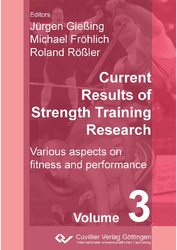| Areas | |
|---|---|
| Serie de libros (96) |
1378
|
| Nachhaltigkeit |
3
|
| Gesundheitswesen |
1
|
| Letra |
2362
|
| Medienwissenschaften | 16 |
| Teología | 57 |
| Filosofía | 102 |
| Derecho | 422 |
| Economía | 850 |
| Ciencias sociales | 416 |
| Ciencias del deporte | 48 |
| Psicología | 233 |
| Educación | 190 |
| Historia | 182 |
| Arte | 110 |
| Ciencias culturales | 165 |
| Literatur | 116 |
| Lingüística | 88 |
| Ciencias Naturales |
5406
|
| Ciencias Ingeniería |
1790
|
| General |
97
|
|
Leitlinien Unfallchirurgie
5. Auflage bestellen |
|
Erweiterte Suche
Current Results of Strength Training Research (Volumen 3) (Tienda española)
Various aspects on fitness and performance
Michael Fröhlich (Editor)Jürgen Gießing (Editor)
Roland Rößler (Editor)
Previo
Indice, Datei (35 KB)
Lectura de prueba, Datei (66 KB)
There was a time when scholars and coaches advised athletes to avoid strength training because it was believed that it would make them slow and muscle-bound and would thereby have a negative impact on their athletic performance. Another concern was that strength training would have a detrimental effect on joints and ligaments. Athletes faced the dilemma of needing strength to perform at a certain level without the increase in muscle weight caused by strength training. Science seemed to prove that gaining muscle weight makes athletes slower since force, (body) mass and acceleration interact with each other (f= m × a). Based on this formula a (acceleration) decreases, when m (body mass) is increased.
Many athletes already knew from personal experience that in fact this was not inevitably the case. If the increase in body weight is mainly caused by hypertrophy of fast-twitch muscle fibre, athletes can indeed move faster even when there is a slight increase in body weight. Since muscle hypertrophy often goes along with a reduction of body fat, body weight changes may be negligible.
In the meantime, the beneficial effects of strength training for many aspects of fitness and performance have been proven. It has become generally accepted that resistance training not only improves performance of competitive athletes in many sports but also offers multiple health benefits. Strength training is a topic that is being researched and studied from many different perspectives as shown in the diverse contributions to this book. These aspects include: Strength testing in basketball, eccentrics and HIT, applying social cognitive theories of behaviour to explain resistance exercise participation, muscle conditioning for soccer players, protein supplementation strategies, repetition speed and TUT in single- vs. multiple-set training, insights gained from kinematic and kinetic analyses of movement which make it obvious that children are not miniature adults, outcome-effects of high intensity pre- vs. post-exhaustion in hypertrophy training, and the effects of high intensity interval training on insulin action.
| ISBN-10 (Impresion) | 3954040166 |
| ISBN-13 (Impresion) | 9783954040162 |
| ISBN-13 (E-Book) | 9783736940161 |
| Formato | B5 |
| Idioma | Inglés |
| Numero de paginas | 132 |
| Laminacion de la cubierta | mate |
| Edicion | 1 Aufl. |
| Serie | Current Results of Strength Training Research |
| Volumen | 3 |
| Lugar de publicacion | Göttingen |
| Fecha de publicacion | 08.02.2012 |
| Clasificacion simple | Libro de divulgacion |
| Area |
Ciencias del deporte
|
| Palabras claves | Krafttraining, Trainingsmethodik, Kinder/Jugendliche, Entwicklung, Muskelaufbau, Hypertrophie, Intensitätstechniken, Einsatztraining, Mehrsatztraining, Trainingsbelastung, subjektive Einschätzung |








